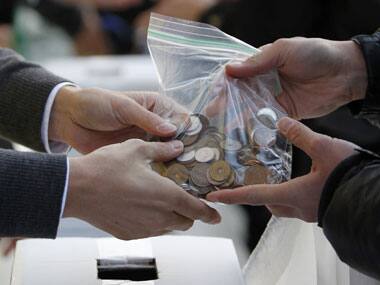Individuals are borrowing more money from banks to buy durables, homes or simply against fixed deposits. The industry continued to borrow the same amount of money last year from banks despite spiralling interest rates.
If rising interest rates were supposed to bring down demand for money, there are no indications of any slowdown. The RBI statistics clearly shows that interest rates are unlikely to see any change of course soon.
The Reserve Bank of India numbers on credit deployment by commercial banks show that non-food credit deployment grew 21.9 percent year-on-year to Rs 36,83,627 crore in May 2011.
[caption id=“attachment_34638” align=“alignleft” width=“380” caption=“Rising interest rates have not had a significant impact on demand and borrowing from the industry. Reuters”]
 [/caption]
[/caption]
Here are some key highlights and comment:
• On a year-on-year (y-o-y) basis, non-food gross bank credit increased by 21.9 percent in May 2011 as compared with 18.1 percent in the corresponding period of last year.
FP Comment: This clearly shows that rising interest rates have not had a significant impact on demand and borrowing from the industry. This is a clear indicator that money will remain expensive going forward as demand for credit continues to rise.
• Credit to agriculture on a y-o-y basis increased by 12.8 percent in May 2011 as compared with 21.0 percent in the previous year.
FP Comment: The slowdown in the credit to the agriculture is an indicator that agriculture production could be lower this year. This shows that less number of farmers found the need to cultivate and took advantage of job guarantee schemes of the government like NREGA.
Impact Shorts
More Shorts• Credit to industry increased by 26.7 percent (y-o-y) in May 2011 as compared with 25.8 percent in the previous year, led by infrastructure, metals and metal products, engineering, mining and quarrying and rubber, plastic and their products.
FP Comment: The strong growth in credit to industry is also an indicator that companies are not worried about the sharp rise in interest rates. Over the past 14 months, RBI has hiked interest rates 10 times. This has not affected companies from borrowing money. This clearly shows that there is no let up in credit demand of the industry and that core industries are ramping up capacities to meet the demand for goods and services.
• Credit to the services sector increased by 21.8 percent (y-o-y) in May 2011 as compared with 15.0 percent in the previous year.
FP comment: Transport, financial services, tourism continue to borrow more money from banks indicating a strong demand scenario. The demand for credit from services indicates that expansion plans have been executed by companies. The services industry typically generates cash from operations that is good enough for sustaining nominal growth.
• Credit growth to NBFCs at 54.4 percent (y-o-y) in May 2011 was significantly higher than 17.5 percent during the corresponding period last year.
FP Comment: This is an indicator that transport finance and personal borrowing continues to remain robust.
• Credit to the commercial real estate (CRE) sector increased 19.9 percent (y-o-y) in May 2011 against 1.2 percent in the year-ago period.
FP Comment: The increase in credit to the commercial real estate space indicates an increase in demand for housing. Home loans also reported a 17.2 percent growth during the May 2011 quarter. It must be noted here that non-metro cities are witnessing a strong growth in construction activity. The cost of construction has gone up due to rising commodity and labour costs. Real estate companies have not indicated in the fourth quarter results that demand has grown significantly.
• On a y-o-y basis, personal loans increased 17.7 per cent in May 2011, in comparison with 5.6 percent during the corresponding period of the previous year. Most of the components of personal loans such as housing, advances against fixed deposits, vehicle loans and consumer durables registered accelerated growth.
FP Comment: Personal loans have witnessed a surge. This indicates that consumers are borrowing briskly to buy new homes, cars and consumer durables. The increase of 24 percent in borrowing for vehicles indicates that discount strategy of car and commercial vehicle companies have worked. The June 2011 data for the automobile segment indicated a growth 15-20 percent in vehicle numbers across categories.
)